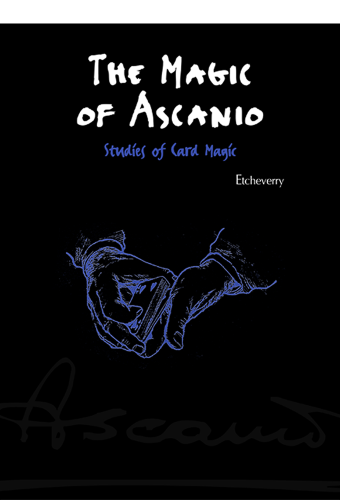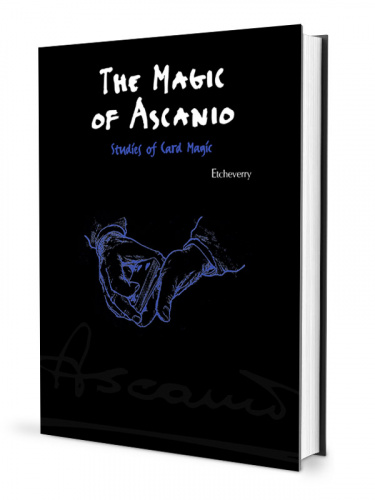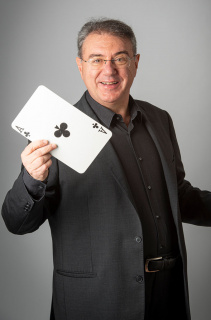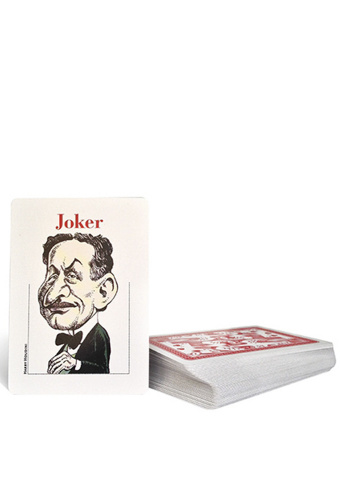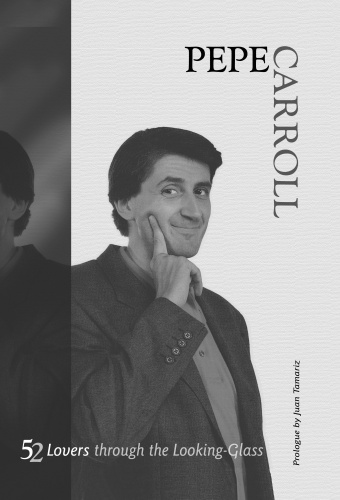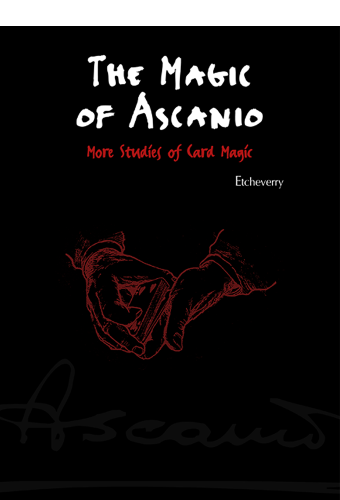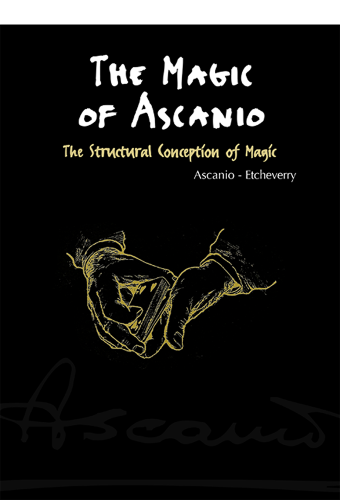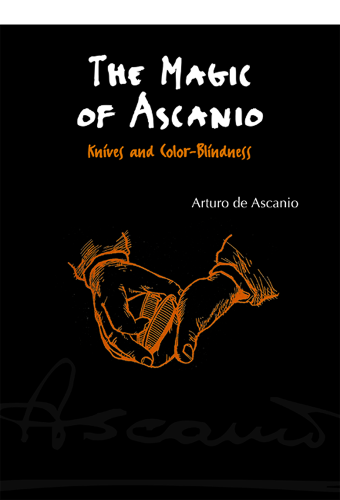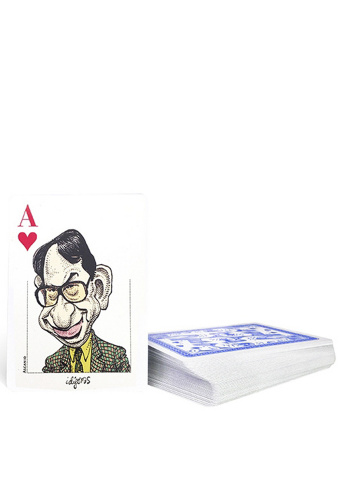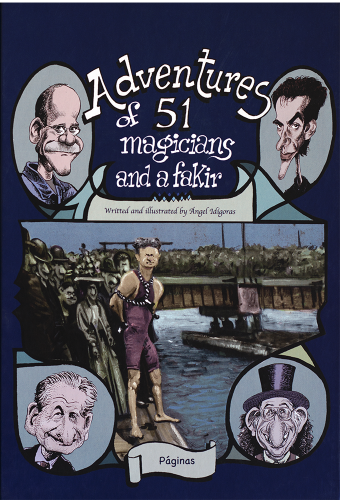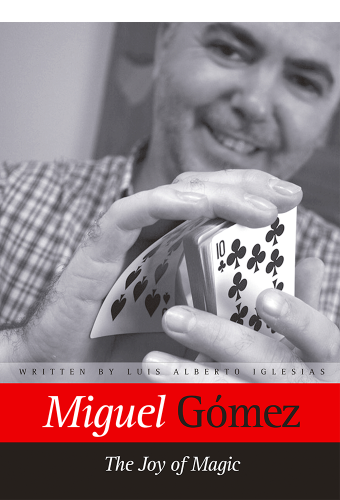The Magic of Ascanio Volume 2 Studies of Card Magic
Etcheverry/Ascanio
978-84-89749-53-559,00€
Año de Edición: 2006
Traducción: Rafael Benatar
Producción Gráfica: ilustraciones y fotografías: Jesús Almendro, Luis Hernández Trueba, Miguel Fernández Palacios, José Antonio Vega y Gustavo Otero
320 pags.
Binding: hardcover
Format: 24cmx17cm
The Magic of Ascanio offers you, in four volumes, the complete work of the Maestro who changed the direction of magic in Spain and influenced many successful performers.
Learn all about the legacy of a true master of our art: his ground-breaking theories, his legendary card routines and sleights, and his magic with pocket knives.
This second volume, with forewords by Roberto Giobbi and Aurelio Paviato, contains an exhaustive study of the Ascanio Spread and its variants, and all the lay-downs. These sleights, the cornerstones of Ascanio's magic, have never been explained so thoroughly before. The careful study of this section alone will give you a complete understanding of these marvelous sleights.
Get ready for the pleasant journey of studying the early versions of Ascanio's classics. Oil and Water using the Ascanio Spread (a three-phase routine) and Father Ace and Sons (versions 66 and 67) will take you into the wonderful world of Ascanio's routining. See the theory in action, with examples of concepts explained in the first volume, such as the Parenthesis of Forgetfulness, the Anti-Contrasting Parenthesis, Stressing the Initial Situation, Slow Execution, misdirection, and the In-Transit Actions.
The next three chapters include magic by Ascanio's mentors, Kaps and Carles, by his colleagues Dany Ray and Fu Manchu, and by one of his idols in magic: Ed Marlo, all with the Ascanio treatment. This section contains tricks shown to Ascanio by these great masters.
Chapter Seven includes Ascanio's favorite routines: If You Don't Pay Attention..., Aunt Enriqueta's Aces, The Trick I Would Show Dai Vernon, Sleightless Oil and Water (or so it seems), and Aces with Love. In Chapter Eight two other Ascanio favorites are described: The Wriggling Aces and Don't Blink! Revisited. The Trick I Would Show Dai Vernon is a lesson on Conditioned Naturalness, and The Wriggling Aces was part of his winning act at FISM in Amsterdam 1970.
Chapter Nine includes two Ascanian classics: A Baroque Transposition and The Mechanical Strength of Thought.
Chapter Ten finally brings you some of Ascanio's minor masterpieces such as: Dolores's Trick, The Pathology of Cards, X - 1 = 0, Triumph, Eight-Card Oil and Water, The Nine Facts, Antagonistic Aces, and A Hunger for Dreaming.
Binding: hardcover
Format: 24cmx17cm
The Magic of Ascanio offers you, in four volumes, the complete work of the Maestro who changed the direction of magic in Spain and influenced many successful performers.
Learn all about the legacy of a true master of our art: his ground-breaking theories, his legendary card routines and sleights, and his magic with pocket knives.
This second volume, with forewords by Roberto Giobbi and Aurelio Paviato, contains an exhaustive study of the Ascanio Spread and its variants, and all the lay-downs. These sleights, the cornerstones of Ascanio's magic, have never been explained so thoroughly before. The careful study of this section alone will give you a complete understanding of these marvelous sleights.
Get ready for the pleasant journey of studying the early versions of Ascanio's classics. Oil and Water using the Ascanio Spread (a three-phase routine) and Father Ace and Sons (versions 66 and 67) will take you into the wonderful world of Ascanio's routining. See the theory in action, with examples of concepts explained in the first volume, such as the Parenthesis of Forgetfulness, the Anti-Contrasting Parenthesis, Stressing the Initial Situation, Slow Execution, misdirection, and the In-Transit Actions.
The next three chapters include magic by Ascanio's mentors, Kaps and Carles, by his colleagues Dany Ray and Fu Manchu, and by one of his idols in magic: Ed Marlo, all with the Ascanio treatment. This section contains tricks shown to Ascanio by these great masters.
Chapter Seven includes Ascanio's favorite routines: If You Don't Pay Attention..., Aunt Enriqueta's Aces, The Trick I Would Show Dai Vernon, Sleightless Oil and Water (or so it seems), and Aces with Love. In Chapter Eight two other Ascanio favorites are described: The Wriggling Aces and Don't Blink! Revisited. The Trick I Would Show Dai Vernon is a lesson on Conditioned Naturalness, and The Wriggling Aces was part of his winning act at FISM in Amsterdam 1970.
Chapter Nine includes two Ascanian classics: A Baroque Transposition and The Mechanical Strength of Thought.
Chapter Ten finally brings you some of Ascanio's minor masterpieces such as: Dolores's Trick, The Pathology of Cards, X - 1 = 0, Triumph, Eight-Card Oil and Water, The Nine Facts, Antagonistic Aces, and A Hunger for Dreaming.
Table of Contents
A Preface by Roberto Giobbi//Foreword by Aurelio Paviato//Chapter One: The Ascanio Spread and its Variants//Chapter Two: The Lay-Downs and their Combination with the Ascanio Spread//Chapter Three: Early Versions//Chapter Four: His Mentors//Chapter Five: His Comrades//Chapter Six: Ed Marlo//Chapter Seven: Beloved Favorites//Chapter Eight: Other Favorites//Chapter Nine: Two Classics//Chapter Ten: Minor Masterpieces
A Preface by Roberto Giobbi//Foreword by Aurelio Paviato//Chapter One: The Ascanio Spread and its Variants//Chapter Two: The Lay-Downs and their Combination with the Ascanio Spread//Chapter Three: Early Versions//Chapter Four: His Mentors//Chapter Five: His Comrades//Chapter Six: Ed Marlo//Chapter Seven: Beloved Favorites//Chapter Eight: Other Favorites//Chapter Nine: Two Classics//Chapter Ten: Minor Masterpieces
Preface
Many might have thought of it, but one person has done it single-handedly: Jesús Etcheverry has compiled, edited, rewritten, and annotated the complete body of Arturo de Ascanio’s life’s work, bringing together what had previously been scattered in books, lecture notes, magazine articles, audio recordings, and video tapes. And he has brought it together in three monumental oeuvres, of which this is the second tome. Being asked by Jesús (a dear friend for many years) to write this prologue is both an honor and a privilege. It is easy to find the reasons for doing so while going back to my timeline, the architecture of which has been greatly influenced by somebody who called me his “spiritual son”: Arturo de Ascanio.
The First Encounter.
I still vividly remember the first time I met Arturo; it was at the FISM convention in 1979, in Brussels. The first thing that I felt was his human kindness. The second thing was the fact that he almost immediately started telling me about some wonderful magical secrets of his. I recall the very first thing he showed me: it was a double lift technique he had recently created that he called La Avanzadilla Ascanio, (described in this book as The Floating Double) which is only one of the hundreds of marvelous items described in this second volume of The Magic of Ascanio. Considering that I was only twenty at the time and had no credentials at all in the world of magic, I found all of this quite amazing and wonderful.
The Story Continues.
The following year, in March 1980, I spent a study week at Juan Tamariz's home. It was then that I saw Arturo's first performance. Juan had invited him and some other magic friends to his former home on Lope de Rueda Street, where many of the world's finest magic sessions have been held. The subject of the group discussion was card penetrations. I had just finished performing my handling of Derek Dingle's Through and Through and thought I had made a good impression on the group. Then Arturo performed his version of Dr. Jacob Daley's Cards through the Table, the cryptic description of which can be found in The Daley Notebooks. In this effect, four cards appear to penetrate the table top from under the table top and reappear under a piece of cardboard which is held above it.
The Revelation.
Once the performance was over, it became clear to me that I had just witnessed a masterpiece. And because in Madrid they speak very openly about secrets—which is a major reason why Madrid has several world-class close-up performers such as Juan Tamariz, Camilo Vázquez, and José Carroll, to name just a few—the group was about to be treated to the explanation of the trick just performed. Or perhaps I should say: Arturo de Ascanio gave an academic talk on the scientific and artistic structure of a pièce (to borrow a Hofzinser expression). It slowly dawned on me why the trick just performed was a pièce de résistance. Arturo explained to us every movement and each word that he used in the routine, why he did this rather than that, where you had to look and where not to look and, above all, for how long. He also discussed when to tighten and relax your body, and even at what angle the feet (which were under the table!) should be positioned. I immediately understood that the impression the trick just performed had made on all of us was, clearly and without the shadow of a doubt, due to the understanding and conscious application of the underlying causes. Need I say I was impressed?
Actually Arturo's version had no longer anything to do with Daley's original version. Obviously the concept proposed by the originator remained, but Arturo's scientific analysis and artistic interpretation elevated it to a new height and brought it into another dimension.
Listening to the explanation of a trick by Arturo is like reading philosophy. It's not just about content and it's not just about form. It's about something intangible created as a product of the two: about a third dimension that creates depth and instills life to an otherwise flat picture. He makes you stop and ponder about notions that are fundamental, and not only about magic. I loved listening to Arturo when he talked personally and also to read what he wrote as this gives me a chance to stop and follow my own thoughts that were triggered by an utterance of his.
The Essence.
Talking and listening to Arturo’s explanations of a sleight or a routine made you slap your forehead again and again and once again and made you think: “This is simply brilliant and brilliantly simple: How is it possible that nobody up to now has been able to put it that way?” This has never happened to me with any other magician I have listened to, with the possible exception of Juan Tamariz. This is not to say that there are no other magic geniuses around—there were and there still are, of course. How fortunate are we to have had Dai Vernon, Tony Slydini and Albert Goshman. And how even more immensely fortunate am I to have had the privilege of listening to their wisdom and seeing their art performed. But none of them had Arturo’s ability to be broad and deep, and at the same time speak consciously and precisely about all those aspects that make a person a genius: a discipline, an art, and at the same time a science.
Again and again I have been surprised at the simplicity with which Arturo was able to formulate and connect complex thoughts. Hitherto obscure and cryptic ideas all of a sudden became transparent and identifiable. I am reminded of artists as opposed as Charlie Chaplin or Picasso who had the ability to make their art so clear, that it could be appreciated immediately by a totally diverse audience.
There have been and there will always be brilliant exponents of the art of magic who intuitively or intellectually understand the essence of magic. Wasn't Fred Kaps a formidable example of an intuitive magician? These people will be able to tell others how things should be done and what things not to do in order to be better. However, in almost all of the cases of such brilliance that I have witnessed the “theory” is reduced to an accumulation of very good tips which is, of course, good enough to make good performers.
Arturo thought on another level. His is an understanding of the theory of the art. Theory, first of all, describes on an abstract level what we do on a practical level. In order to become a theory, however, a superior scientific system has to be created which groups all of its elements in a transparent order showing the relationship of the elements with each other as well as their relationship with the superimposed whole. In the tradition of Gestalt, the theory itself is always more than the sum of its parts. This is the fundamental difference between an accumulation of very good professional tips and a theoretical structure. This is the difference between the talented professional and the genius of Arturo. And this is good enough to make good artists.
The Circle Closes.
Over two decades have passed in which I have learned to appreciate the depth of Arturo's genius. In 1995 the Jornadas Cartomágicas de El Escorial took place as they do every year. The famous Alex Elmsley was the guest of honor. Nobody will ever forget the moment on Sunday morning when Arturo gave his traditional personal performance which this time included some of Elmsley's most brilliant conceptions: All Backs and Ambitious Stranger which are, indeed, described in the third volume of The Magic of Ascanio. To those who saw the performance nothing needs to be said; to those who didn't see the performance nothing can be said. Arturo's analysis of presentation, construction, technique and handling of these two themes had given birth to two completely new routines. At the end two masters shook hands in mutual respect.
About this book.
When French writer André Gide said: "I like only the unfinished- because I can complete it", he certainly did not mean Arturo's work, which is finished to the nth degree. Arturo never cared for quickies. He performed opulent masterworks that required time and an attentive audience.
I do not merely speak for myself, but for a fairly large group of people, specifically those of the Escuela Mágica de Madrid, when I say that Arturo has shifted paradigms; he has remolded and, what is more, created new beliefs concerning magic. Sometimes by the sole use of a specific word he has opened the door to a new concept. What is amazing to me is the fact that many of these concepts were not invented by him, but he saw them, took them, named them, arranged and ararnged them, and built them into a castle, a solid castle into which others were generously invited in to share his insights- and turned out that this castle was the academy of the art of magic. These extraordinary books are the blueprints of this unique building.
Finale.
For all who speak and read Spanish and for those who have been around Arturo for a shorter or longer period, what I wrote is blatantly obvious. (I cajole myself into the ilusion that the only thing I did was to put it in better words than most have done in the past -and with this I reveal a healthy portion of Ascanian immodesty which influenced me, too).
Arturo is the father of a new kind of magic. He is at the base of the constructivist magic pyramid (to borrow a term coined for magic by Juan Tamariz, a giant of our art). Nobody before him has so consciously understood and so lucidly described the effect of the magician's words and actions on the spectator's mind. With his closest friends, whom he liked to call his sons and brothers, and the members of the Escuela Mágica de Madrid, which he co-founded together with Juan Tamariz, he has generated architects, who will continue what a premature death prevented him from accomplishing.
Arturo de Acanio passed away at the age of 68 in his home in Madrid on Sunday, the 6th of April. He died while performing The Aces of My Exam (yes, this is also in these books)- one of his all-time favourites, which is his personal interpretation of the Stanley Collins Aces, originally taught to him by Fred Kaps, whom he called his master. Although his body left us far too early, his spirit will never leave us. He will be with us each time we pick up a deck of cards- together with Robert-Houdin, Hofzinser, and Vernon.
Epilogue.
Jesús, Arturo's memory is certainly omnipresent in my mind and in that of many others who have known him, but now you have written these books and he has a monument. For this I -and all who will allow me to speak for them- will be eternally greatful to you. Olé for Jesús (and a case of Rioja Imperial 1982)!
Roberto Giobbi
Muttenz. July, 2000
*******
Foreword
The first book of Ascanio I ever read, a few years before meeting him, was Navajas y Daltonismo (Knives and Color-Blindness). I was about twenty and that was a revelation. The connection of attitude and thought, the admiration and respect for the author, were immediate.
This new book by my friend Jesús Etcheverry has brought me a moment of reflection and inspiration. The figure of Ascanio is already a part of the history of our art. His influence has been significant -first in Spain and then in the whole world- and,along with Tamariz and others, has been a major force in modeling the identity of what is now universally known as the Spanish School. Not surprisingly, he was one of the first to sign the Manifiesto of the Escuela Mágica de Madird (EMM), a fundamental artistic movement in the magic scene of Europe and of the world, born out of the imagination of Juan Tamariz.
I think Ascanio's main concern, and what bothered him the most, was the fact that this art of ours was not (and still isn't) regarded as such by most people. His thoughts and discussions frequently tackled artistic issues, and his essays had the goal of providing us the necessary tools to value and enrich our work. He offered us his most notable and unquestinable skill: his linguistic competence and his dialectic capacity. A well-read man with a vast cultural perspective, he served magic with his knowledge. He identified, defined, and named countless empirical aspects of magic by codifying them and making them culturally transferable. He left us the means for our individual growth and by doing that has favored the much-needed evolution of artistic magic.
We are, therefore, speaking of a true cultural heritage, which reaches us today with total clarity and throughness thanks to the work of Jesús Etcheverry, and which is reflected in the commentaries on the tricks and routines. In the purest ascanian style, Etcheverry points out to the reader the moments in which precise structures and linguistic strategies are applied, as is the case with Thematic Misdirection. He alsho highlights and clearly indicates where the Expository Phase, the Magical Effect, and the Proof take place; he even tells us when the Parenthesis of Forgetfulness or the celebrated In-Transit Actions are being used. In this style I discover and recognize Maestro Ascanio and meet, once again, the man with whom I shared so much friendship and affection.
Since Ascanio seldom worked professionally in front of a lay audience, it could be argued that his routines are somewhat academic abd far-fetched. But this fact cannot be used to diminish either the intellectual value or the cultural contribution to be found in Ascanio's work as well as in Etcheverry's. On the contrary, I believe the study and performance of these tricks and routines offers us an extraordinary help for the understanding of magic as a whole, let alone the fact that they can be integrated to a professional repertoire.
What Etcheverry brings us through these pages is an important legacy, of which wem present-day conjures, should become responsible. I know that many take up magic as a pastime, as a non-commiting hobby. I am also aware that -even worse- many professionals who boast about their many public performances, have a superficial attitude towards magic. It's not for me to judge or condem such individual attitudes, but I insist on the fact -mostly as a general rule that we should always bear in mind- that when we approach this art seriously, we are making a commitment with its history and assuming a responsability towards its future, which depends directly on our behaviour.
May Ascanio's thinking and theachings never be forgotten. And this is, among many other things, the first achievement of Jesús Etcheverry's work.
Aurelio Paviato.
Vigevano, October 2000.
Many might have thought of it, but one person has done it single-handedly: Jesús Etcheverry has compiled, edited, rewritten, and annotated the complete body of Arturo de Ascanio’s life’s work, bringing together what had previously been scattered in books, lecture notes, magazine articles, audio recordings, and video tapes. And he has brought it together in three monumental oeuvres, of which this is the second tome. Being asked by Jesús (a dear friend for many years) to write this prologue is both an honor and a privilege. It is easy to find the reasons for doing so while going back to my timeline, the architecture of which has been greatly influenced by somebody who called me his “spiritual son”: Arturo de Ascanio.
The First Encounter.
I still vividly remember the first time I met Arturo; it was at the FISM convention in 1979, in Brussels. The first thing that I felt was his human kindness. The second thing was the fact that he almost immediately started telling me about some wonderful magical secrets of his. I recall the very first thing he showed me: it was a double lift technique he had recently created that he called La Avanzadilla Ascanio, (described in this book as The Floating Double) which is only one of the hundreds of marvelous items described in this second volume of The Magic of Ascanio. Considering that I was only twenty at the time and had no credentials at all in the world of magic, I found all of this quite amazing and wonderful.
The Story Continues.
The following year, in March 1980, I spent a study week at Juan Tamariz's home. It was then that I saw Arturo's first performance. Juan had invited him and some other magic friends to his former home on Lope de Rueda Street, where many of the world's finest magic sessions have been held. The subject of the group discussion was card penetrations. I had just finished performing my handling of Derek Dingle's Through and Through and thought I had made a good impression on the group. Then Arturo performed his version of Dr. Jacob Daley's Cards through the Table, the cryptic description of which can be found in The Daley Notebooks. In this effect, four cards appear to penetrate the table top from under the table top and reappear under a piece of cardboard which is held above it.
The Revelation.
Once the performance was over, it became clear to me that I had just witnessed a masterpiece. And because in Madrid they speak very openly about secrets—which is a major reason why Madrid has several world-class close-up performers such as Juan Tamariz, Camilo Vázquez, and José Carroll, to name just a few—the group was about to be treated to the explanation of the trick just performed. Or perhaps I should say: Arturo de Ascanio gave an academic talk on the scientific and artistic structure of a pièce (to borrow a Hofzinser expression). It slowly dawned on me why the trick just performed was a pièce de résistance. Arturo explained to us every movement and each word that he used in the routine, why he did this rather than that, where you had to look and where not to look and, above all, for how long. He also discussed when to tighten and relax your body, and even at what angle the feet (which were under the table!) should be positioned. I immediately understood that the impression the trick just performed had made on all of us was, clearly and without the shadow of a doubt, due to the understanding and conscious application of the underlying causes. Need I say I was impressed?
Actually Arturo's version had no longer anything to do with Daley's original version. Obviously the concept proposed by the originator remained, but Arturo's scientific analysis and artistic interpretation elevated it to a new height and brought it into another dimension.
Listening to the explanation of a trick by Arturo is like reading philosophy. It's not just about content and it's not just about form. It's about something intangible created as a product of the two: about a third dimension that creates depth and instills life to an otherwise flat picture. He makes you stop and ponder about notions that are fundamental, and not only about magic. I loved listening to Arturo when he talked personally and also to read what he wrote as this gives me a chance to stop and follow my own thoughts that were triggered by an utterance of his.
The Essence.
Talking and listening to Arturo’s explanations of a sleight or a routine made you slap your forehead again and again and once again and made you think: “This is simply brilliant and brilliantly simple: How is it possible that nobody up to now has been able to put it that way?” This has never happened to me with any other magician I have listened to, with the possible exception of Juan Tamariz. This is not to say that there are no other magic geniuses around—there were and there still are, of course. How fortunate are we to have had Dai Vernon, Tony Slydini and Albert Goshman. And how even more immensely fortunate am I to have had the privilege of listening to their wisdom and seeing their art performed. But none of them had Arturo’s ability to be broad and deep, and at the same time speak consciously and precisely about all those aspects that make a person a genius: a discipline, an art, and at the same time a science.
Again and again I have been surprised at the simplicity with which Arturo was able to formulate and connect complex thoughts. Hitherto obscure and cryptic ideas all of a sudden became transparent and identifiable. I am reminded of artists as opposed as Charlie Chaplin or Picasso who had the ability to make their art so clear, that it could be appreciated immediately by a totally diverse audience.
There have been and there will always be brilliant exponents of the art of magic who intuitively or intellectually understand the essence of magic. Wasn't Fred Kaps a formidable example of an intuitive magician? These people will be able to tell others how things should be done and what things not to do in order to be better. However, in almost all of the cases of such brilliance that I have witnessed the “theory” is reduced to an accumulation of very good tips which is, of course, good enough to make good performers.
Arturo thought on another level. His is an understanding of the theory of the art. Theory, first of all, describes on an abstract level what we do on a practical level. In order to become a theory, however, a superior scientific system has to be created which groups all of its elements in a transparent order showing the relationship of the elements with each other as well as their relationship with the superimposed whole. In the tradition of Gestalt, the theory itself is always more than the sum of its parts. This is the fundamental difference between an accumulation of very good professional tips and a theoretical structure. This is the difference between the talented professional and the genius of Arturo. And this is good enough to make good artists.
The Circle Closes.
Over two decades have passed in which I have learned to appreciate the depth of Arturo's genius. In 1995 the Jornadas Cartomágicas de El Escorial took place as they do every year. The famous Alex Elmsley was the guest of honor. Nobody will ever forget the moment on Sunday morning when Arturo gave his traditional personal performance which this time included some of Elmsley's most brilliant conceptions: All Backs and Ambitious Stranger which are, indeed, described in the third volume of The Magic of Ascanio. To those who saw the performance nothing needs to be said; to those who didn't see the performance nothing can be said. Arturo's analysis of presentation, construction, technique and handling of these two themes had given birth to two completely new routines. At the end two masters shook hands in mutual respect.
About this book.
When French writer André Gide said: "I like only the unfinished- because I can complete it", he certainly did not mean Arturo's work, which is finished to the nth degree. Arturo never cared for quickies. He performed opulent masterworks that required time and an attentive audience.
I do not merely speak for myself, but for a fairly large group of people, specifically those of the Escuela Mágica de Madrid, when I say that Arturo has shifted paradigms; he has remolded and, what is more, created new beliefs concerning magic. Sometimes by the sole use of a specific word he has opened the door to a new concept. What is amazing to me is the fact that many of these concepts were not invented by him, but he saw them, took them, named them, arranged and ararnged them, and built them into a castle, a solid castle into which others were generously invited in to share his insights- and turned out that this castle was the academy of the art of magic. These extraordinary books are the blueprints of this unique building.
Finale.
For all who speak and read Spanish and for those who have been around Arturo for a shorter or longer period, what I wrote is blatantly obvious. (I cajole myself into the ilusion that the only thing I did was to put it in better words than most have done in the past -and with this I reveal a healthy portion of Ascanian immodesty which influenced me, too).
Arturo is the father of a new kind of magic. He is at the base of the constructivist magic pyramid (to borrow a term coined for magic by Juan Tamariz, a giant of our art). Nobody before him has so consciously understood and so lucidly described the effect of the magician's words and actions on the spectator's mind. With his closest friends, whom he liked to call his sons and brothers, and the members of the Escuela Mágica de Madrid, which he co-founded together with Juan Tamariz, he has generated architects, who will continue what a premature death prevented him from accomplishing.
Arturo de Acanio passed away at the age of 68 in his home in Madrid on Sunday, the 6th of April. He died while performing The Aces of My Exam (yes, this is also in these books)- one of his all-time favourites, which is his personal interpretation of the Stanley Collins Aces, originally taught to him by Fred Kaps, whom he called his master. Although his body left us far too early, his spirit will never leave us. He will be with us each time we pick up a deck of cards- together with Robert-Houdin, Hofzinser, and Vernon.
Epilogue.
Jesús, Arturo's memory is certainly omnipresent in my mind and in that of many others who have known him, but now you have written these books and he has a monument. For this I -and all who will allow me to speak for them- will be eternally greatful to you. Olé for Jesús (and a case of Rioja Imperial 1982)!
Roberto Giobbi
Muttenz. July, 2000
*******
Foreword
The first book of Ascanio I ever read, a few years before meeting him, was Navajas y Daltonismo (Knives and Color-Blindness). I was about twenty and that was a revelation. The connection of attitude and thought, the admiration and respect for the author, were immediate.
This new book by my friend Jesús Etcheverry has brought me a moment of reflection and inspiration. The figure of Ascanio is already a part of the history of our art. His influence has been significant -first in Spain and then in the whole world- and,along with Tamariz and others, has been a major force in modeling the identity of what is now universally known as the Spanish School. Not surprisingly, he was one of the first to sign the Manifiesto of the Escuela Mágica de Madird (EMM), a fundamental artistic movement in the magic scene of Europe and of the world, born out of the imagination of Juan Tamariz.
I think Ascanio's main concern, and what bothered him the most, was the fact that this art of ours was not (and still isn't) regarded as such by most people. His thoughts and discussions frequently tackled artistic issues, and his essays had the goal of providing us the necessary tools to value and enrich our work. He offered us his most notable and unquestinable skill: his linguistic competence and his dialectic capacity. A well-read man with a vast cultural perspective, he served magic with his knowledge. He identified, defined, and named countless empirical aspects of magic by codifying them and making them culturally transferable. He left us the means for our individual growth and by doing that has favored the much-needed evolution of artistic magic.
We are, therefore, speaking of a true cultural heritage, which reaches us today with total clarity and throughness thanks to the work of Jesús Etcheverry, and which is reflected in the commentaries on the tricks and routines. In the purest ascanian style, Etcheverry points out to the reader the moments in which precise structures and linguistic strategies are applied, as is the case with Thematic Misdirection. He alsho highlights and clearly indicates where the Expository Phase, the Magical Effect, and the Proof take place; he even tells us when the Parenthesis of Forgetfulness or the celebrated In-Transit Actions are being used. In this style I discover and recognize Maestro Ascanio and meet, once again, the man with whom I shared so much friendship and affection.
Since Ascanio seldom worked professionally in front of a lay audience, it could be argued that his routines are somewhat academic abd far-fetched. But this fact cannot be used to diminish either the intellectual value or the cultural contribution to be found in Ascanio's work as well as in Etcheverry's. On the contrary, I believe the study and performance of these tricks and routines offers us an extraordinary help for the understanding of magic as a whole, let alone the fact that they can be integrated to a professional repertoire.
What Etcheverry brings us through these pages is an important legacy, of which wem present-day conjures, should become responsible. I know that many take up magic as a pastime, as a non-commiting hobby. I am also aware that -even worse- many professionals who boast about their many public performances, have a superficial attitude towards magic. It's not for me to judge or condem such individual attitudes, but I insist on the fact -mostly as a general rule that we should always bear in mind- that when we approach this art seriously, we are making a commitment with its history and assuming a responsability towards its future, which depends directly on our behaviour.
May Ascanio's thinking and theachings never be forgotten. And this is, among many other things, the first achievement of Jesús Etcheverry's work.
Aurelio Paviato.
Vigevano, October 2000.

